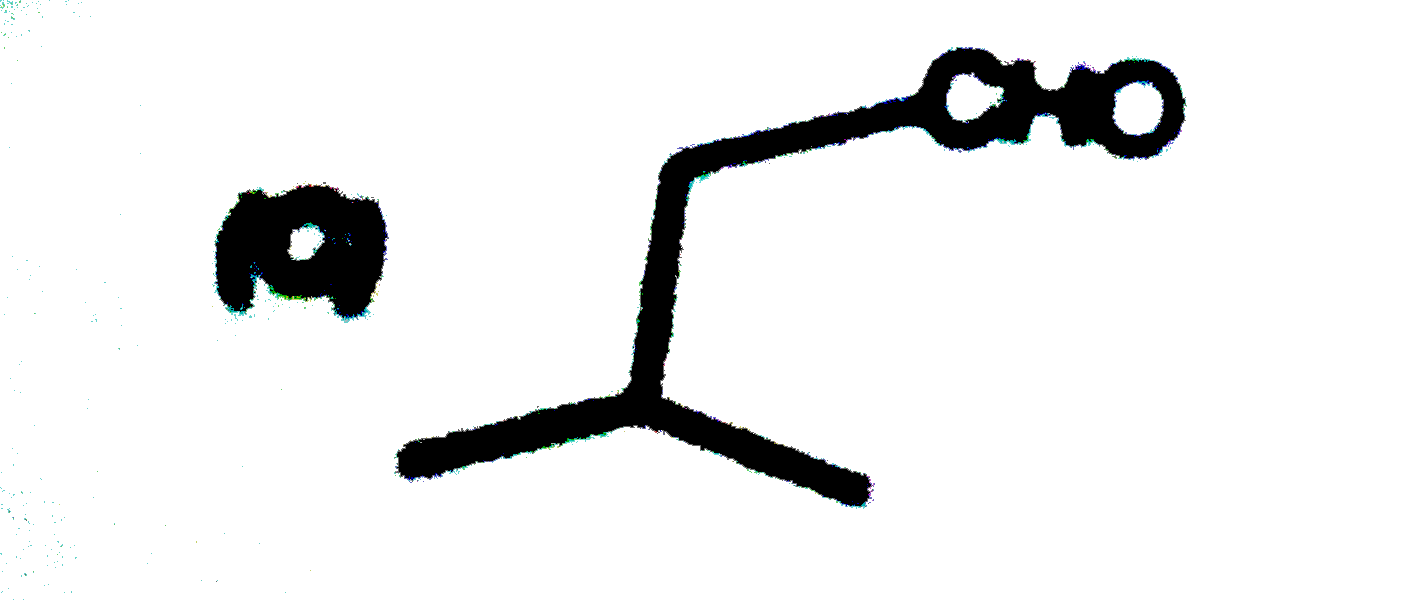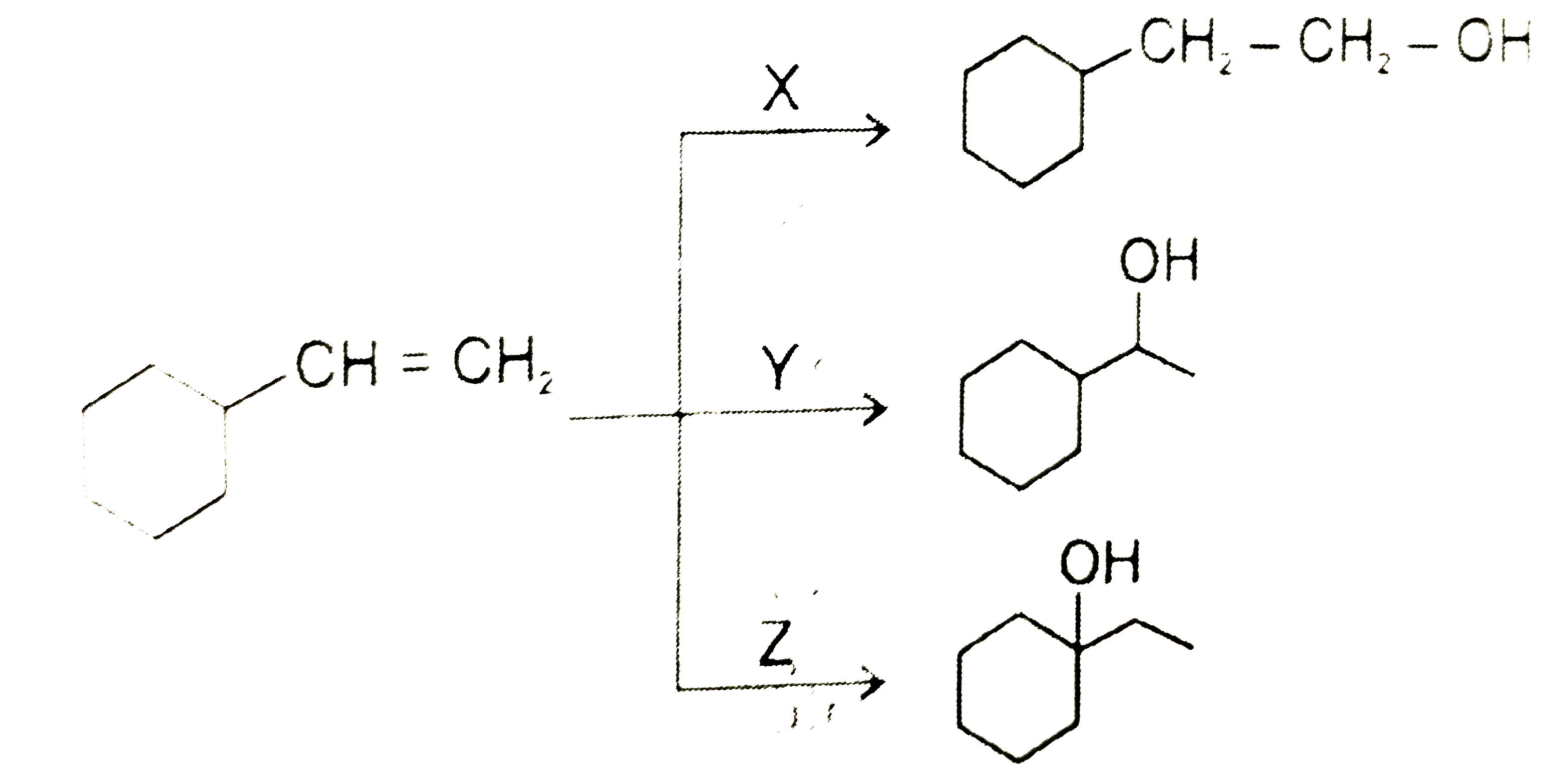An alkyl halide (X) on reaction with ethanolic sodium hydroxide forms an alkene (Y) which on further reaction with HBr gives the same alkyl halide.The alkene (Y) on reaction with HBr/ peroxide followed by reaction with Mg metal followed by reaction with HCN produces an aldehyde (Z).Z is :




The correct Answer is:B, C
To solve the problem step by step, we need to analyze the reactions described in the question.
Step 1: Identify the Alkyl Halide (X)
Let’s assume the alkyl halide (X) is a simple alkyl halide, such as bromoethane (C2H5Br).
Step 2: Reaction with Ethanolic Sodium Hydroxide
When alkyl halide (X) reacts with ethanolic sodium hydroxide (NaOH), it undergoes an elimination reaction (dehydrohalogenation) to form an alkene (Y).
- For example, bromoethane (C2H5Br) reacts with NaOH to form ethene (C2H4).
Reaction:
C2H5Br + NaOH (ethanol) → C2H4 (Y) + NaBr + H2O
Step 3: Reaction of Alkene (Y) with HBr
The alkene (Y) then reacts with HBr to give back the same alkyl halide (X).
- In our case, ethene (C2H4) reacts with HBr to form bromoethane (C2H5Br).
Reaction:
C2H4 (Y) + HBr → C2H5Br (X)
Step 4: Reaction of Alkene (Y) with HBr in Presence of Peroxide
Now, if the alkene (Y) reacts with HBr in the presence of peroxide, it follows the anti-Markovnikov addition rule, leading to the formation of a bromoalkane where bromine adds to the less substituted carbon.
- For ethene, this step is not applicable as it is symmetrical, but if we consider a more complex alkene, the product would be different.
Example Reaction:
C2H4 + HBr (in presence of peroxide) → C2H5Br (still the same for symmetrical alkenes)
Step 5: Reaction with Magnesium Metal
The product from the previous step (bromoalkane) reacts with magnesium metal to form a Grignard reagent.
- For example, C2H5Br + Mg → C2H5MgBr
Step 6: Reaction with HCN
The Grignard reagent (C2H5MgBr) then reacts with HCN to form an intermediate that eventually leads to the formation of an aldehyde (Z).
- The reaction with HCN introduces a cyanide group, and upon hydrolysis, it will convert to an aldehyde.
Final Reaction:
C2H5MgBr + HCN → C2H5-CN (intermediate) → C2H5CHO (aldehyde Z)
Conclusion
The final product (aldehyde Z) is ethyl aldehyde (acetaldehyde), which is represented as CH3CHO.
Final Answer:
Z is: Acetaldehyde (CH3CHO)
---
Let’s assume the alkyl halide (X) is a simple alkyl halide, such as bromoethane (C2H5Br).
When alkyl halide (X) reacts with ethanolic sodium hydroxide (NaOH), it undergoes an elimination reaction (dehydrohalogenation) to form an alkene (Y).
- For example, bromoethane (C2H5Br) reacts with NaOH to form ethene (C2H4).
C2H5Br + NaOH (ethanol) → C2H4 (Y) + NaBr + H2O
The alkene (Y) then reacts with HBr to give back the same alkyl halide (X).
- In our case, ethene (C2H4) reacts with HBr to form bromoethane (C2H5Br).
C2H4 (Y) + HBr → C2H5Br (X)
Now, if the alkene (Y) reacts with HBr in the presence of peroxide, it follows the anti-Markovnikov addition rule, leading to the formation of a bromoalkane where bromine adds to the less substituted carbon.
- For ethene, this step is not applicable as it is symmetrical, but if we consider a more complex alkene, the product would be different.
C2H4 + HBr (in presence of peroxide) → C2H5Br (still the same for symmetrical alkenes)
The product from the previous step (bromoalkane) reacts with magnesium metal to form a Grignard reagent.
- For example, C2H5Br + Mg → C2H5MgBr
The Grignard reagent (C2H5MgBr) then reacts with HCN to form an intermediate that eventually leads to the formation of an aldehyde (Z).
- The reaction with HCN introduces a cyanide group, and upon hydrolysis, it will convert to an aldehyde.
C2H5MgBr + HCN → C2H5-CN (intermediate) → C2H5CHO (aldehyde Z)
The final product (aldehyde Z) is ethyl aldehyde (acetaldehyde), which is represented as CH3CHO.
Z is: Acetaldehyde (CH3CHO)
Topper's Solved these Questions
- ORGANIC REACTION MECHANISMS-IVBOOK - RESONANCE ENGLISHCHAPTER - ORGANIC REACTION MECHANISMS-IVEXERCISE - APSP PART-3
22 Videos
- ORGANIC REACTION MECHANISMS-IVBOOK - RESONANCE ENGLISHCHAPTER - ORGANIC REACTION MECHANISMS-IVEXERCISE - APSP PART-1
30 Videos
- ORGANIC REACTION MECHANISMS - IIBOOK - RESONANCE ENGLISHCHAPTER - ORGANIC REACTION MECHANISMS - IIEXERCISE - APSP Part - 3
22 Videos
- PERIODIC TABLE & PERIODICITYBOOK - RESONANCE ENGLISHCHAPTER - PERIODIC TABLE & PERIODICITYEXERCISE - ORGANIC CHEMISTRY(BASIC CONCEPTS)
27 Videos
Similar Questions
Knowledge Check
Which of the following reactions will produce aldehyde?
A BH3C−CH=CH2CO+H2−−−−−−−→CO2(CO)8CH3C−C≡CH−−−−−→OϴH/H2ODH3C−C−o=ChHg+2,H2SO4−−−−−−−−→
BH3C−CH=CH2CO+H2−−−−−−−→CO2(CO)8CH3C−C≡CH−−−−−→OϴH/H2ODH3C−C−o=ChHg+2,H2SO4−−−−−−−−→The order of reactivities of the following alkyl halides for a SN2 reaction is :
Aa. RF > RCI > RBr > RIBb. RF > RBr > RCI > RICc. RCI > RBr > RF > RIDd. RI > RBr > RCI > RFWhich of the following reactions will give least substituted alkene?
A B
B C
C D
D
The product of the reaction of sodium acetylide with alkyl halide is
View SolutionWhich of the following reactions give alkylation product :
View SolutionAlcohol can be prepared from alken by which of the following reaction
View SolutionName
Reaction when an alkyl halide is treated with alcoholic potassium hydroxide.
View SolutionWhich of the following reactions will not give Hofmann alkene ?
View Solution

